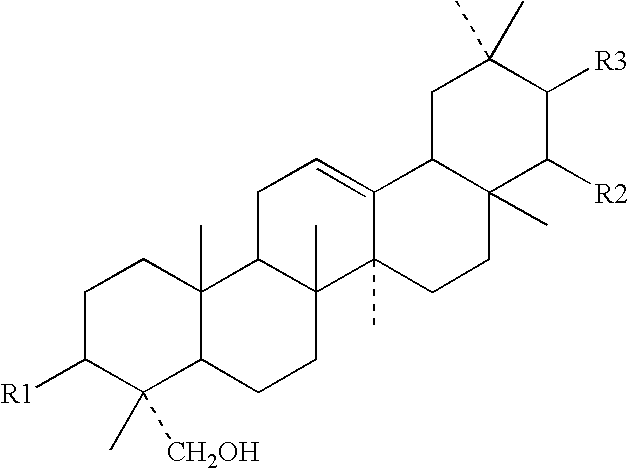Soybean saponin-containing material and process for producing the same
a technology of soybean saponin and material, which is applied in the field of soybean saponin-containing material and a process for producing the same, can solve the problems of reducing a yield and difficult to separate them by utilizing these properties, and achieves the effect of high yield
- Summary
- Abstract
- Description
- Claims
- Application Information
AI Technical Summary
Benefits of technology
Problems solved by technology
Method used
Image
Examples
example 1
[0067] To 500 g of raw soybean hypocotyls was added 2.0 L of water-containing ethanol having a water content of 25% by volume and the resultant mixture was stirred and extracted at 40° C. After separation of the extract by filtration, again thereto was added 2.0 L of water-containing ethanol having a water content of 25% by volume, and the resultant mixture was similarly extracted. The resultant two extracts were combined (the resultant extract was referred to as a “water-containing polar organic solvent extraction solution”). The extract was condensed at 40° C. under reduced pressure.
[0068] The extract thus obtained was dissolved in water and the resulting solution was applied to a column (100 ml) packed with a porous styrene-divinylbenzene type synthetic adsorption resin Diaion HP-20 (manufactured by Mitsubishi Chemical Corporation) at SV2.
[0069] Then, the column was washed with water-containing ethanol having a water content of 80% by volume and further eluted with water-contai...
example 2
[0070] According to the same manner as that described in Example 1, a saponin-containing material was obtained except that extraction of raw soybean hypocotyls with water-containing ethanol was carried out at 70° C.
example 3
[0071] According to the same manner as that described in Example 1, a saponin-containing material was obtained except that extraction of raw soybean hypocotyls with water-containing ethanol was carried out at 15° C.
PUM
 Login to View More
Login to View More Abstract
Description
Claims
Application Information
 Login to View More
Login to View More - R&D
- Intellectual Property
- Life Sciences
- Materials
- Tech Scout
- Unparalleled Data Quality
- Higher Quality Content
- 60% Fewer Hallucinations
Browse by: Latest US Patents, China's latest patents, Technical Efficacy Thesaurus, Application Domain, Technology Topic, Popular Technical Reports.
© 2025 PatSnap. All rights reserved.Legal|Privacy policy|Modern Slavery Act Transparency Statement|Sitemap|About US| Contact US: help@patsnap.com

